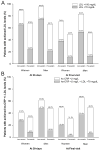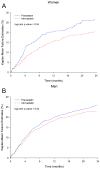Benefit of intensive statin therapy in women: results from PROVE IT-TIMI 22
- PMID: 21487089
- PMCID: PMC3097284
- DOI: 10.1161/CIRCOUTCOMES.110.957720
Benefit of intensive statin therapy in women: results from PROVE IT-TIMI 22
Abstract
Background: Despite the known benefit of intensive statin therapy for reducing future cardiovascular events, its effectiveness in women has been questioned by some.
Methods and results: In the Pravastatin or Atorvastatin Evaluation and Infection Therapy-Thrombolysis in Myocardial Infarction 22 (PROVE IT-TIMI 22) trial, 911 (21.9%) women and 3251 (78.1%) men were randomized to intensive statin (atorvastatin 80 mg) versus standard therapy (pravastatin 40 mg) therapy for a median duration of 2.1 years. The primary end point was death, myocardial infarction, unstable angina; revascularization (occurring after 30 days); or stroke. Safety end points included elevations in liver function tests, creatine kinase, and myalgias/myositis. Women had a reduction in low-density lipoprotein (LDL) of 42.8% from baseline at 30 days (to a median of 60 mg/dL) in the intensive therapy arm, with 88.8% reaching the LDL goal of <100 mg/dL and 65.0% of <70 mg/dL, compared with a 16.8% reduction in LDL (to a median of 88 mg/dL) in the standard therapy arm. Women receiving intensive statin therapy had a significant 25% relative reduction over standard dose (hazard ratio, 0.75; 95% CI, 0.57 to 0.99; P=0.04) for the primary composite end point compared with a 14% reduction for men (hazard ratio, 0.86; 95% CI, 0.75 to 0.99; P=0.04; P-interaction, 0.38). No differences were observed between sexes for safety (all P-interaction ≥0.11).
Conclusions: This trial provides evidence that both women and men derived benefit from intensive statin therapy after acute coronary syndrome, and thus, sex should not be a factor in determining who should be treated with intensive statin therapy.
Trial registration: ClinicalTrials.gov NCT00382460.
Conflict of interest statement
Figures





Comment in
-
Clinical trial subgroups: challenges and opportunities in describing the benefits of therapy.Circ Cardiovasc Qual Outcomes. 2011 May;4(3):266-7. doi: 10.1161/CIRCOUTCOMES.111.961128. Circ Cardiovasc Qual Outcomes. 2011. PMID: 21586724 No abstract available.
Similar articles
-
Reduction in recurrent cardiovascular events with intensive lipid-lowering statin therapy compared with moderate lipid-lowering statin therapy after acute coronary syndromes from the PROVE IT-TIMI 22 (Pravastatin or Atorvastatin Evaluation and Infection Therapy-Thrombolysis In Myocardial Infarction 22) trial.J Am Coll Cardiol. 2009 Dec 15;54(25):2358-62. doi: 10.1016/j.jacc.2009.10.005. J Am Coll Cardiol. 2009. PMID: 20082923 Clinical Trial.
-
Can low-density lipoprotein be too low? The safety and efficacy of achieving very low low-density lipoprotein with intensive statin therapy: a PROVE IT-TIMI 22 substudy.J Am Coll Cardiol. 2005 Oct 18;46(8):1411-6. doi: 10.1016/j.jacc.2005.04.064. J Am Coll Cardiol. 2005. PMID: 16226163
-
Improved outcome after acute coronary syndromes with an intensive versus standard lipid-lowering regimen: results from the Pravastatin or Atorvastatin Evaluation and Infection Therapy-Thrombolysis in Myocardial Infarction 22 (PROVE IT-TIMI 22) trial.Am J Med. 2005 Dec;118 Suppl 12A:28-35. doi: 10.1016/j.amjmed.2005.09.014. Am J Med. 2005. PMID: 16356805
-
Intensive statin therapy in acute coronary syndromes: clinical benefits and vascular biology.Curr Opin Lipidol. 2004 Dec;15(6):637-43. doi: 10.1097/00041433-200412000-00003. Curr Opin Lipidol. 2004. PMID: 15529022 Review.
-
Early time to benefit with intensive statin treatment: could it be the pleiotropic effects?Am J Cardiol. 2005 Sep 5;96(5A):54F-60F. doi: 10.1016/j.amjcard.2005.06.027. Am J Cardiol. 2005. PMID: 16126024 Review.
Cited by
-
Gender disparities in prevalence by diagnostic criteria, treatment and mortality of newly diagnosed acute myocardial infarction in Korean adults.Sci Rep. 2023 Mar 13;13(1):4120. doi: 10.1038/s41598-023-31014-y. Sci Rep. 2023. PMID: 36914709 Free PMC article.
-
Challenges in Optimizing Lipid Management in Women.Cardiovasc Drugs Ther. 2022 Dec;36(6):1197-1220. doi: 10.1007/s10557-021-07273-0. Epub 2021 Oct 18. Cardiovasc Drugs Ther. 2022. PMID: 34661802 Review.
-
Hearts apart: exploring sex disparity in the global and regional burden of ischemic heart disease; a systematic analysis from the global burden of disease study 1990-2021.BMC Cardiovasc Disord. 2025 May 2;25(1):346. doi: 10.1186/s12872-025-04770-0. BMC Cardiovasc Disord. 2025. PMID: 40316911 Free PMC article.
-
Sex differences in endothelial function of aged hypertriglyceridemic rats - effect of atorvastatin treatment.Interdiscip Toxicol. 2012 Sep;5(3):155-8. doi: 10.2478/v10102-012-0025-2. Interdiscip Toxicol. 2012. PMID: 23554556 Free PMC article.
-
Treatment of Coronary Artery Disease in Women.Methodist Debakey Cardiovasc J. 2017 Oct-Dec;13(4):201-208. doi: 10.14797/mdcj-13-4-201. Methodist Debakey Cardiovasc J. 2017. PMID: 29744012 Free PMC article. Review.
References
-
- Mosca L, Banka CL, Benjamin EJ, Berra K, Bushnell C, Dolor RJ, Ganiats TG, Gomes AS, Gornik HL, Gracia C, Gulati M, Haan CK, Judelson DR, Keenan N, Kelepouris E, Michos ED, Newby LK, Oparil S, Ouyang P, Oz MC, Petitti D, Pinn VW, Redberg RF, Scott R, Sherif K, Smith SC, Jr, Sopko G, Steinhorn RH, Stone NJ, Taubert KA, Todd BA, Urbina E, Wenger NK. Evidence-based guidelines for cardiovascular disease prevention in women: 2007 update. J Am Coll Cardiol. 2007;49:1230–1250. - PubMed
-
- Lloyd-Jones D, Adams RJ, Brown TM, Carnethon M, Dai S, De Simone G, Ferguson TB, Ford E, Furie K, Gillespie C, Go A, Greenlund K, Haase N, Hailpern S, Ho PM, Howard V, Kissela B, Kittner S, Lackland D, Lisabeth L, Marelli A, McDermott MM, Meigs J, Mozaffarian D, Mussolino M, Nichol G, Roger V, Rosamond W, Sacco R, Sorlie P, Stafford R, Thom T, Wasserthiel-Smoller S, Wong ND, Wylie-Rosett J. Heart Disease and Stroke Statistics--2010 Update. A Report From the American Heart Association. Circulation. 2009 - PubMed
-
- Downs JR, Clearfield M, Weis S, Whitney E, Shapiro DR, Beere PA, Langendorfer A, Stein EA, Kruyer W, Gotto AM., Jr Primary prevention of acute coronary events with lovastatin in men and women with average cholesterol levels: results of AFCAPS/TexCAPS. Air Force/Texas Coronary Atherosclerosis Prevention Study JAMA. 1998;279:1615–1622. - PubMed
-
- Randomised trial of cholesterol lowering in 4444 patients with coronary heart disease: the Scandinavian Simvastatin Survival Study (4S) Lancet. 1994;344:1383–1389. - PubMed
-
- Prevention of cardiovascular events and death with pravastatin in patients with coronary heart disease and a broad range of initial cholesterol levels. The Long-Term Intervention with Pravastatin in Ischaemic Disease (LIPID) Study Group. N Engl J Med. 1998;339:1349–1357. - PubMed
Publication types
MeSH terms
Substances
Associated data
Grants and funding
LinkOut - more resources
Full Text Sources
Medical

